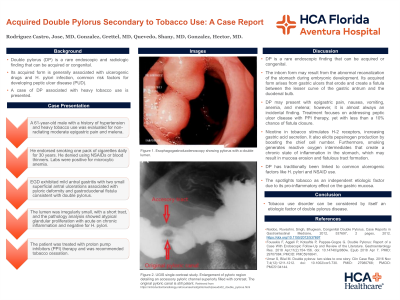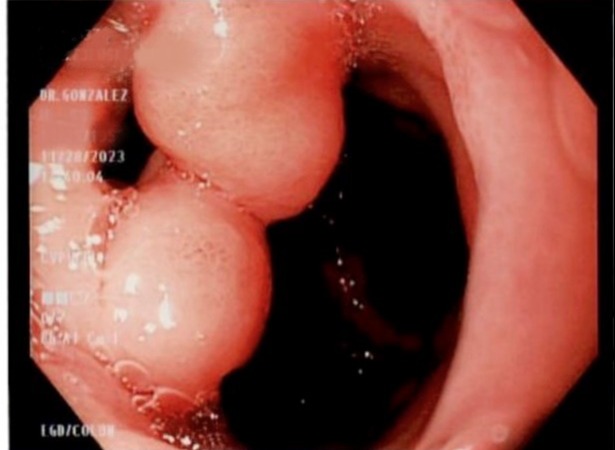Sunday Poster Session
Category: Stomach
P1704 - Acquired Double Pylorus Due to Tobacco Use: A Case Report
Sunday, October 27, 2024
3:30 PM - 7:00 PM ET
Location: Exhibit Hall E

Has Audio

Jose L. Rodriguez Castro, MD
Aventura Hospital
Aventura, FL
Presenting Author(s)
Jose L. Rodriguez Castro, MD1, Grettel Gonzalez Garcia, MD2, Daniel Heller, MD1, Hector L. Gonzalez, MD1
1Aventura Hospital, Aventura, FL; 2Newark Beth Israel Medical Center, Newark, NJ
Introduction: Double pylorus (DP) is a rare endoscopic and radiologic finding that can be acquired or congenital. Its acquired form is generally associated with ulcerogenic drugs and H. pylori infection, which are common risk factors for developing peptic ulcer disease (PUD). A case of DP associated with heavy tobacco use is presented.
Case Description/Methods: Our patient is a 61-year-old male with a history of hypertension and heavy tobacco use who was evaluated for non-radiating moderate epigastric pain and melena. He endorsed smoking one pack of cigarettes daily for 30 years. He denied using non-steroidal anti-inflammatories (NSAIDs) or blood thinners. Laboratory studies were positive for microcytic anemia. The esophagogastroduodenoscopy (EGD) exhibited mild antral gastritis with two small superficial antral ulcerations (Forrest IIC) associated with pyloric deformity and gastroduodenal fistula consistent with double pylorus. The lumen of the fistula was irregularly small, with a short tract, and the pathology analysis showed atypical glandular proliferation with acute on chronic inflammation and a negative Helicobacter pylori immunostaining test. The patient was treated with proton pump inhibitors (PPI) therapy and was recommended tobacco cessation.
Discussion: DP is a rare endoscopic finding that can be acquired or congenital. The inborn form may result from the abnormal recanalization of the stomach during embryonic development. Its acquired form arises from gastric ulcers that erode and create a fistula between the lesser curve of the gastric antrum and the duodenal bulb. DP may present with epigastric pain, nausea, vomiting, anemia, and melena; however, it is almost always an incidental finding. Treatment focuses on addressing peptic ulcer disease with PPI therapy, yet with less than a 10% chance of fistula closure. Nicotine in tobacco stimulates H-2 receptors, increasing gastric acid secretion. It also elicits pepsinogen production by boosting the chief cell number. Furthermore, smoking generates reactive oxygen intermediates that create a chronic state of inflammation in the stomach, which may result in mucosa erosion and fistulous tract formation. DP has traditionally been linked to common ulcerogenic factors like H. pylori and NSAID use. Yet, our case spotlights tobacco as an independent etiologic factor due to its pro-inflammatory effect on the gastric mucosa. Further studies are required to assess potential causation and correlation.

Disclosures:
Jose L. Rodriguez Castro, MD1, Grettel Gonzalez Garcia, MD2, Daniel Heller, MD1, Hector L. Gonzalez, MD1. P1704 - Acquired Double Pylorus Due to Tobacco Use: A Case Report, ACG 2024 Annual Scientific Meeting Abstracts. Philadelphia, PA: American College of Gastroenterology.
1Aventura Hospital, Aventura, FL; 2Newark Beth Israel Medical Center, Newark, NJ
Introduction: Double pylorus (DP) is a rare endoscopic and radiologic finding that can be acquired or congenital. Its acquired form is generally associated with ulcerogenic drugs and H. pylori infection, which are common risk factors for developing peptic ulcer disease (PUD). A case of DP associated with heavy tobacco use is presented.
Case Description/Methods: Our patient is a 61-year-old male with a history of hypertension and heavy tobacco use who was evaluated for non-radiating moderate epigastric pain and melena. He endorsed smoking one pack of cigarettes daily for 30 years. He denied using non-steroidal anti-inflammatories (NSAIDs) or blood thinners. Laboratory studies were positive for microcytic anemia. The esophagogastroduodenoscopy (EGD) exhibited mild antral gastritis with two small superficial antral ulcerations (Forrest IIC) associated with pyloric deformity and gastroduodenal fistula consistent with double pylorus. The lumen of the fistula was irregularly small, with a short tract, and the pathology analysis showed atypical glandular proliferation with acute on chronic inflammation and a negative Helicobacter pylori immunostaining test. The patient was treated with proton pump inhibitors (PPI) therapy and was recommended tobacco cessation.
Discussion: DP is a rare endoscopic finding that can be acquired or congenital. The inborn form may result from the abnormal recanalization of the stomach during embryonic development. Its acquired form arises from gastric ulcers that erode and create a fistula between the lesser curve of the gastric antrum and the duodenal bulb. DP may present with epigastric pain, nausea, vomiting, anemia, and melena; however, it is almost always an incidental finding. Treatment focuses on addressing peptic ulcer disease with PPI therapy, yet with less than a 10% chance of fistula closure. Nicotine in tobacco stimulates H-2 receptors, increasing gastric acid secretion. It also elicits pepsinogen production by boosting the chief cell number. Furthermore, smoking generates reactive oxygen intermediates that create a chronic state of inflammation in the stomach, which may result in mucosa erosion and fistulous tract formation. DP has traditionally been linked to common ulcerogenic factors like H. pylori and NSAID use. Yet, our case spotlights tobacco as an independent etiologic factor due to its pro-inflammatory effect on the gastric mucosa. Further studies are required to assess potential causation and correlation.

Figure: Figure 1. Endoscopic view of the pylorus with presence of a gastroduodenal fistula (double pylorus).
Disclosures:
Jose Rodriguez Castro indicated no relevant financial relationships.
Grettel Gonzalez Garcia indicated no relevant financial relationships.
Daniel Heller indicated no relevant financial relationships.
Hector Gonzalez indicated no relevant financial relationships.
Jose L. Rodriguez Castro, MD1, Grettel Gonzalez Garcia, MD2, Daniel Heller, MD1, Hector L. Gonzalez, MD1. P1704 - Acquired Double Pylorus Due to Tobacco Use: A Case Report, ACG 2024 Annual Scientific Meeting Abstracts. Philadelphia, PA: American College of Gastroenterology.
